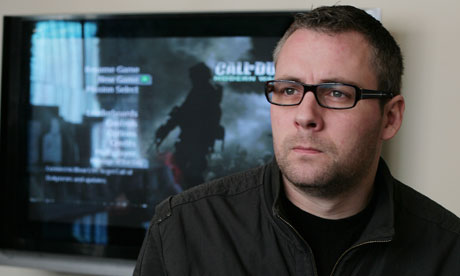
My workplace – and perhaps yours too, or your student house, or wherever you may be – is full of tired, bleary-eyed individuals. Their conversation is about how many kills they had last night, what weapons they used, and who took them out. They're obviously not hardened criminals, but have instead been up late into the night playing the latest hit first person shooter game, Call of Duty: Modern Warfare 3. Shops opened at midnight in November to snaking queues when MW3, as it shall henceforth be known, went on sale. Sixteen days later it had hit the $1bn (£640m) mark in record time; it will be on many Christmas lists and I'm insanely jealous because I can't play it.
This isn't because I haven't got the necessary games consoles or that I don't like shooting people on them. (I have and I do.) But after a mere 30 minutes of playing them, I have to run to the bathroom to throw up. I'm not alone, either. While there is little research into video games and what has been called "simulation sickness", estimates suggest that between 10% and 50% of people may suffer to various degrees. For me, it was triggered the first time I ever played such a game, the PlayStation classic Doom in 1995. A wave of nausea similar to that experienced in the back of cars as a child passenger had me pulling the plug. Yet even as games have got smoother and more sophisticated, this hasn't improved, and gaming remains closed to me.
The most commonly accepted theory for what happens when people feel sick during computer games is that the virtual world they're immersed in provides the illusion of motion – whether your on-screen avatar is walking, running or driving a vehicle – but the player's inner ear doesn't detect any such motion. The part of the brain that regulates vomiting – the area postrema – infers that this disconnect is as a result of hallucinations, and as this may be caused by poisoning, attempts to get the body to purge itself by vomiting. Most research in this area is of a military nature, as modern warfare relies heavily on simulation for training purposes. While they weren't playing Xbox 360 games, The US Army Research Institute for the Behavioral and Social Sciences also studied flight simulators and found that slightly fewer than half of pilots using them reported symptoms similar to motion sickness.
So how can I join in? Dr Louisa Murdin, who recently published a review of scientific evidence on motion sickness for the British Medical Journal, advises: "The choice is between 'habituation', which means building up tolerance by starting with short exposures to provocative stimuli then gradually increasing to longer ones, and drugs that suppress the symptoms but can have side effects. Both are effective but there are advantages and disadvantages to each." I decided to try three of the most frequently recommended remedies: a commonly used car-sickness medicine, Joy-Rides; Travella, a homeopathic remedy; and a relief band worn on the wrist.
I took Joy-Rides as a child, and initially flashbacks to sick-strewn car journeys didn't help. The active ingredient is hyoscine hydrobromide, which is supposed to target the parts of the brain that tell the stomach about motion sickness. You take two 20 minutes before your journey, which I did. I usually get about 30 minutes play before the nausea becomes too much; this time it's 74 minutes before I have to turn off. For one thrilling hour and a quarter I thought I'd found my panacea, but then I had to stop taking down virtual villains as my stomach finally started lurching.
Nelsons Travella, widely available at chemists, contains "a 6c homeopathic potency of apomorph, staphisagria, cocculus, theridion, petroleum, tabacum, nux vomica". You're advised to take four tablets in the two hours before, and two tablets hourly during any journey. The 22 minutes I lasted didn't convert me to homeopathy, nor did the adult travel bands I tried. These offer relief from travel and morning sickness through acupressure. They gave me 38 minutes of play, which I can normally manage anyway.
Many people report that all or some of the three methods I used work for them, to varying degrees, and it's always useful to bear in mind the placebo effect when looking at such things, which may have been countered by my natural scepticism. Regardless, Murdin tells me my experience is consistent with the scientific evidence she reviewed.
Either way, I haven't found a cure. But I still live in hope that the games industry will research simulator sickness so they can reach those of us who are left out.

